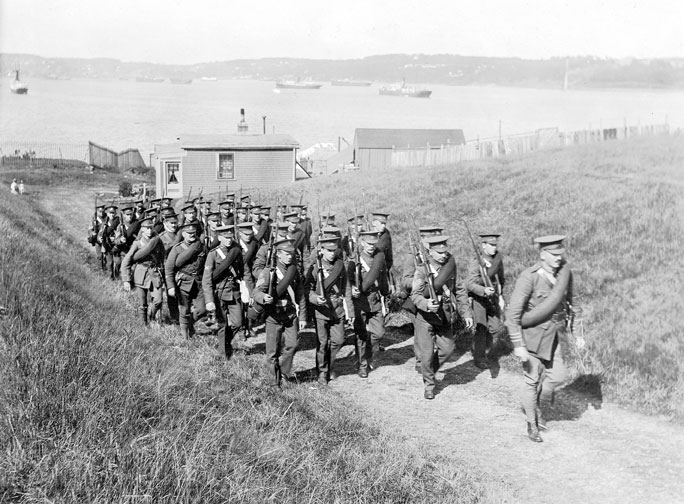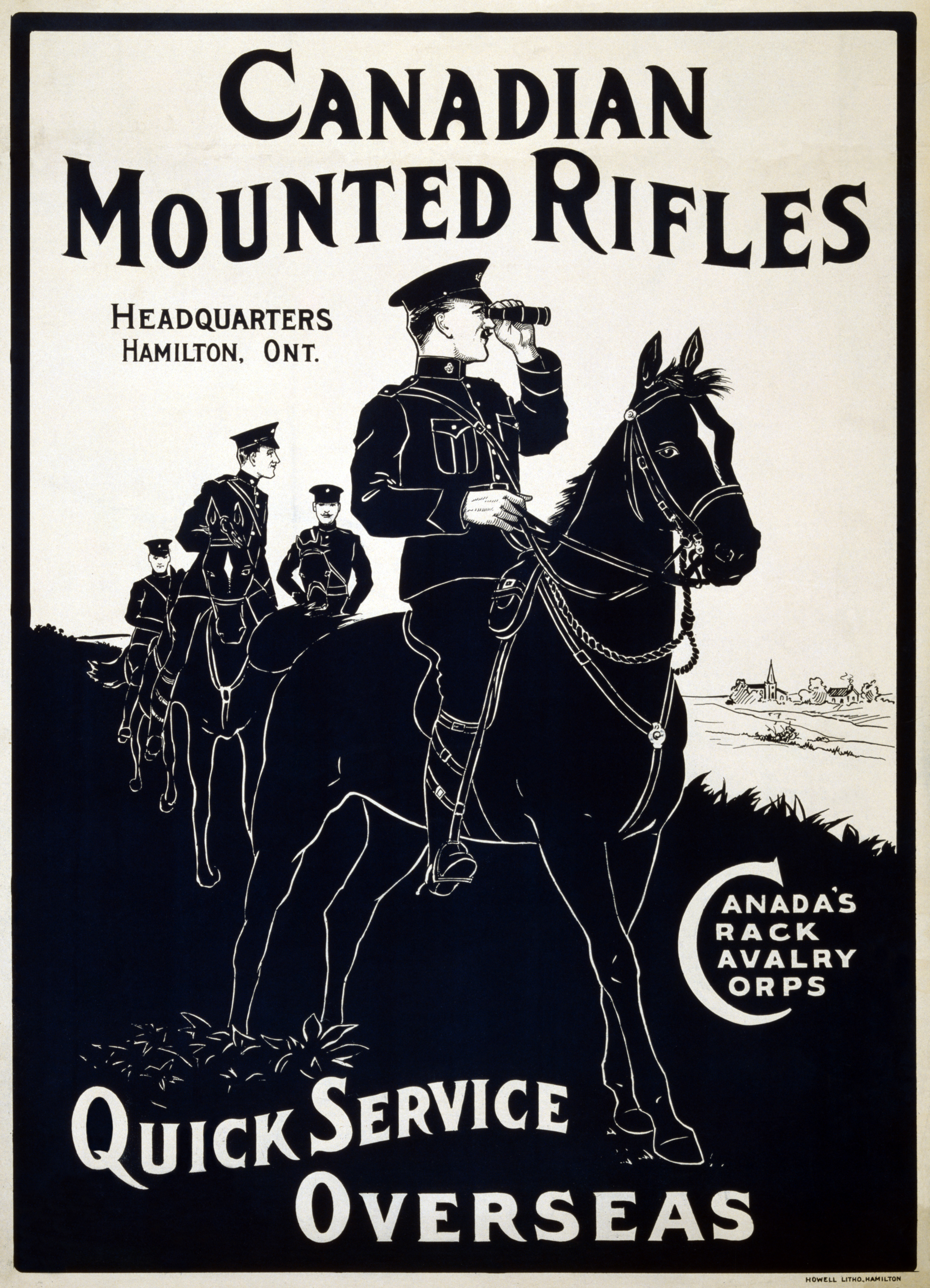|
The Victoria And Haliburton Regiment
The Victoria and Haliburton Regiment was an infantry regiment of the Non-Permanent Active Militia of the Canadian Militia (now the Canadian Army). In 1936, the regiment was Converted from Infantry to Artillery to become the 45th Field Battery RCA and now forms part of the 50th Field Artillery Regiment (The Prince of Wales Rangers), RCA (currently on the Supplementary Order of Battle). Lineage The Victoria and Haliburton Regiment * Originated on 16 November 1866, in Bowmanville, Ontario, as the 45th West Durham Battalion of Infantry. * Redesignated on 1 January 1898, as the 45th Victoria Battalion of Infantry. * Redesignated on 8 May 1900, as the 45th Victoria Regiment. * Redesignated on 16 July 1917, as the 45th Victoria and Haliburton Regiment. * Redesignated on 12 March 1920, as The Victoria and Haliburton Regiment. * Amalgamated on 14 December 1936, with the 45th Field Battery, RCA and Redesignated as the 45th Field Battery (Howitzer), RCA. Perpetuations * 109th Ba ... [...More Info...] [...Related Items...] OR: [Wikipedia] [Google] [Baidu] |
Canada West
The Province of Canada (or the United Province of Canada or the United Canadas) was a British colony in North America from 1841 to 1867. Its formation reflected recommendations made by John Lambton, 1st Earl of Durham, in the Report on the Affairs of British North America following the Rebellions of 1837–1838. The Act of Union 1840, passed on 23 July 1840 by the British Parliament and proclaimed by the Crown on 10 February 1841, merged the Colonies of Upper Canada and Lower Canada by abolishing their separate parliaments and replacing them with a single one with two houses, a Legislative Council as the upper chamber and the Legislative Assembly as the lower chamber. In the aftermath of the Rebellions of 1837–1838, unification of the two Canadas was driven by two factors. Firstly, Upper Canada was near bankruptcy because it lacked stable tax revenues, and needed the resources of the more populous Lower Canada to fund its internal transportation improvements. Secondly, ... [...More Info...] [...Related Items...] OR: [Wikipedia] [Google] [Baidu] |
Otter Commission
The Otter Commission, or Otter Committee, was established after the First World War to tackle a problem created by the chaotic mobilization of the Canadian Expeditionary Force. In 1919 units of the CEF, intended as a wartime expeditionary force, returned to Canada where the Canadian Militia had served during the war performing home defence duties, staffing internment camps, and raising recruits for overseas. Both the CEF and the Militia desired to be perpetuated in the post-war world. The CEF units were proud of their wartime record, while the pre-war Militia had long-standing roots in the community and battle honours dating back as far as the War of 1812. The Commission The commission was headed by General Sir William Dillon Otter. Other members were Major General Archibald Cameron Macdonell, Brigadier General E.A. Cruikshank (who served as Secretary) and Brigadier General A.G.L. McNaughton. Hearings The commission held hearings across the country in the autumn of 1919. The c ... [...More Info...] [...Related Items...] OR: [Wikipedia] [Google] [Baidu] |
124th Battalion (Governor General's Body Guard), CEF
The 124th (Governor General's Body Guard) Battalion, CEF was a unit in the Canadian Expeditionary Force during the First World War. Based in Toronto, Ontario, the unit began recruiting in late 1915 in that city. After sailing to England in August 1916, the battalion was redesignated the 124th Pioneer Battalion, CEF. The battalion is perpetuated by The Royal Regiment of Canada , battle_honours = See #Battle honours , website = , identification_symbol = , identification_symbol_label = Tactical recognition flash , nickname = Royals , battles .... References *Meek, John F. ''Over the Top! The Canadian Infantry in the First World War.'' Orangeville, Ont.: The Author, 1971. {{DEFAULTSORT:124th Battalion (Governor General's Body Guard), Cef Battalions of the Canadian Expeditionary Force Royal Regiment of Canada ... [...More Info...] [...Related Items...] OR: [Wikipedia] [Google] [Baidu] |
38th Battalion (Ottawa), CEF
The 38th Battalion, CEF was a unit of the First World War Canadian Expeditionary Force. It was mobilized in Ottawa and recruited in Ottawa, Brockville, Perth, Prescott and Alexandria. An initial draft of five officers and 251 other ranks was sent to England on 24 June 1915. The battalion embarked at Montreal on 1 August 1915, aboard the ''Caledonian'', disembarking in Bermuda on 12 August 1915. Its strength was 35 officers and 959 other ranks. The battalion embarked at Bermuda on 30 May 1916, aboard the ''Grampian'', disembarking in England on 9 June 1916. Its strength was 35 officers and 1001 other ranks. The battalion arrived in France on 13 August 1916, becoming part of the 4th Canadian Division, 12th Canadian Infantry Brigade. It was later reinforced by the 7th Canadian Reserve Battalion. The battalion returned to England on 6 May 1919, arrived in Canada on 13 June 1919, was demobilized in Ottawa on 15 June 1919, and was disbanded by General Order 149 of 15 September 1920. P ... [...More Info...] [...Related Items...] OR: [Wikipedia] [Google] [Baidu] |
21st Battalion (Eastern Ontario), CEF
The 21st Battalion (Eastern Ontario), CEF was an infantry battalion of the Canadian Expeditionary Force in the Great War. History The battalion was authorized on 7 November 1914 and embarked for Britain on 6 May 1915. It disembarked in France on 15 September 1915, where it fought as part of the 4th Canadian Brigade, 2nd Canadian Division in France and Flanders. The battalion was disbanded on 30 August 1920. The 21st Battalion recruited in Eastern Ontario and was mobilized at Kingston, Ontario. Officers Commanding The 21st Battalion had five Officers Commanding: *Lt.-Col. William St Pierre Hughes, 6 May 1915 – 18 July 1916 *Lt.-Col. E.W. Jones, DSO, 18 July 1916 – 7 January 1917 *Lt.-Col. Thomas F. Elmitt, 7 January 1917 – 1 July 1917 *Lt.-Col. Elmer Watson Jones, DSO, 1 July 1917 – 8 August 1918 *Lt.-Col. H.E. Pense, DSO, 8 August 1918-Demobilization The Ottawa Branch of the 21st Battalion Association erected a memorial plaque at St. Andrew's Presbyterian Church ( ... [...More Info...] [...Related Items...] OR: [Wikipedia] [Google] [Baidu] |
20th Battalion (Central Ontario), CEF
The 20th Battalion (Central Ontario), CEF was a unit of the First World War Canadian Expeditionary Force. Service history The battalion was composed of volunteers from militia units in central Ontario. Much of the unit was drawn from the 12th York Regiment, the Rangers, with men coming from ten other militia regiments – of which four still exist. The unit fought in France and Flanders as part of the 4th Canadian Brigade, 2nd Canadian Division. Notable actions include the Somme, Vimy Ridge, Hill 70, Passchendaele, Amiens, the advance along the Scarpe, Canal du Nord, Canal de le Escault and the advance to Mons in the Last Hundred Days. The battalion was disbanded in 1920. Casualties 4,310 officers and men served in the 20th Battalion during the war altogether. Of them, 843 (19.6%) were killed in action or died of wounds—often having been wounded earlier. Another 1,855 (43%) were wounded, often repeatedly. 91 died of disease or accidentally. Ottawa stopped counting the d ... [...More Info...] [...Related Items...] OR: [Wikipedia] [Google] [Baidu] |
Royal Regiment Of Canadian Artillery
, colors = The guns of the RCA themselves , colors_label = Colours , march = * Slow march: "Royal Artillery Slow March" * Quick march (dismounted parades): "British Grenadiers/ The Voice of the Guns" * Trot past: "Keel Row" * Gallop past (horse artillery only): "Bonnie Dundee" , mascot = , anniversaries = * 1855: Militia Act of 1855 passed by the Parliament of the Province of Canada and creation the first truly Canadian army units * 27 November 1856: first Canadian Artillery unit formed (''Battalion of Montreal Artillery'') * 10 August 1883: ''Regiment of Canadian Artillery'' of the Permanent Active Militia authorized to be formed , equipment = * 105 mm Howitzer, C3 * 105 mm Howitzer, LG1 Mk II * 155 mm Howitzer M777C1 , equipment_label = Current weapon systems , battle_honours = The word la, Ubique, lit=Everywhere, take ... [...More Info...] [...Related Items...] OR: [Wikipedia] [Google] [Baidu] |
Canadian Mounted Rifles
Canadian Mounted Rifles was part of the designation of several mounted infantry units in Canada in the late 19th and early 20th centuries. Units of the Permanent Active Militia Units formed for the Second Boer War Independent squadrons of the Non-Permanent Active Militia Units of the Canadian Expeditionary Force of the First World War See also * List of mounted regiments in the Canadian Expeditionary Force *List of infantry battalions in the Canadian Expeditionary Force *Mounted Infantry * Canadian Militia *History of the Canadian Army *Permanent Active Militia *Non-Permanent Active Militia *Military history of Canada during World War I * Australian Light Horse * Imperial Yeomanry * Otter Commission The Otter Commission, or Otter Committee, was established after the First World War to tackle a problem created by the chaotic mobilization of the Canadian Expeditionary Force. In 1919 units of the CEF, intended as a wartime expeditionary force, ret ... Refer ... [...More Info...] [...Related Items...] OR: [Wikipedia] [Google] [Baidu] |
Strathcona’s Horse
Lord Strathcona's Horse (Royal Canadians) (LdSH C is a regular armoured regiment of the Canadian Army and is Canada’s only tank regiment. Currently based in Edmonton, Alberta, the regiment is part of 3rd Canadian Division's 1 Canadian Mechanized Brigade Group. Members of the regiment are commonly called ''Strathconas'' or ''Strats'' as a short form. It was one of the last regiments in the British Empire to be created and raised by a private individual, Donald Alexander Smith, 1st Baron Strathcona and Mount Royal. The regimental motto is "Perseverance". The colonel-in-chief of the regiment is King Charles III, while the colonel of the regiment is Brigadier-General (Retired) Craig Hilton. The current commanding officer is Lieutenant-Colonel M.J.D. Mallette, and the regimental sergeant major is Chief Warrant Officer R. Englehart. Regimental structure The regiment is currently composed of a regimental headquarters and three sabre squadrons: two tank squadrons (A and B ... [...More Info...] [...Related Items...] OR: [Wikipedia] [Google] [Baidu] |
2nd (Special Service) Battalion, The Royal Canadian Regiment
, colors = , identification_symbol_2 = Maple Leaf (2nd Bn pipes and drums) , identification_symbol_2_label = Tartan , identification_symbol_4 = The RCR , identification_symbol_4_label = Abbreviation , march = Quick – "The Royal Canadian Regiment" (aka "St. Catharines")Slow – "" , mascot = , battles = Fenian RaidsNorth-West RebellionSecond Boer WarFirst World WarSecond World WarKorean WarWar in Afghanistan , notable_commanders = William Dillon Otter , anniversaries = Regimental birthday – 21 DecemberPaardeberg Day – 27 FebruaryPachino Day – 10 JulyMons Day – 10 November Kowang-san Day – 23 October , decorations = Commander-in-Chief Unit Commendation – 1st Battalion: Afghanistan, Operation ARCHER, 2006. , battle_honours = See #Battle honours The Royal Canadian Regiment (RCR) is an infantry ... [...More Info...] [...Related Items...] OR: [Wikipedia] [Google] [Baidu] |
The Midland Battalion
The Midland Provisional Battalion (also known as The Midland Battalion) was a military unit of the Non-Permanent Active Militia of the Canadian Militia (now the Canadian Army) from Eastern Ontario, Canada, which fought in the North-West Rebellion of 1885. Placed under the command of Lieutenant-Colonel A.T.H. Williams of the 46th East Durham Battalion, the battalion consisted of around 370 officers and men by grouping together 8 companies from 7 different Canadian Militia infantry battalions from Eastern Ontario and served during the conflict in General Middleton’s Column of the North West Field Force. The battalion most notably served at the Battle of Batoche, where fighting alongside the 10th Royal Grenadiers and with support from the 90th Winnipeg Rifles, the battalion charged and captured the Métis rifle pits. After the end of the rebellion, the battalion was disbanded in the same year. Organization The Midland Provisional Battalion consisted of eight companies mobilized ... [...More Info...] [...Related Items...] OR: [Wikipedia] [Google] [Baidu] |

.jpg)


